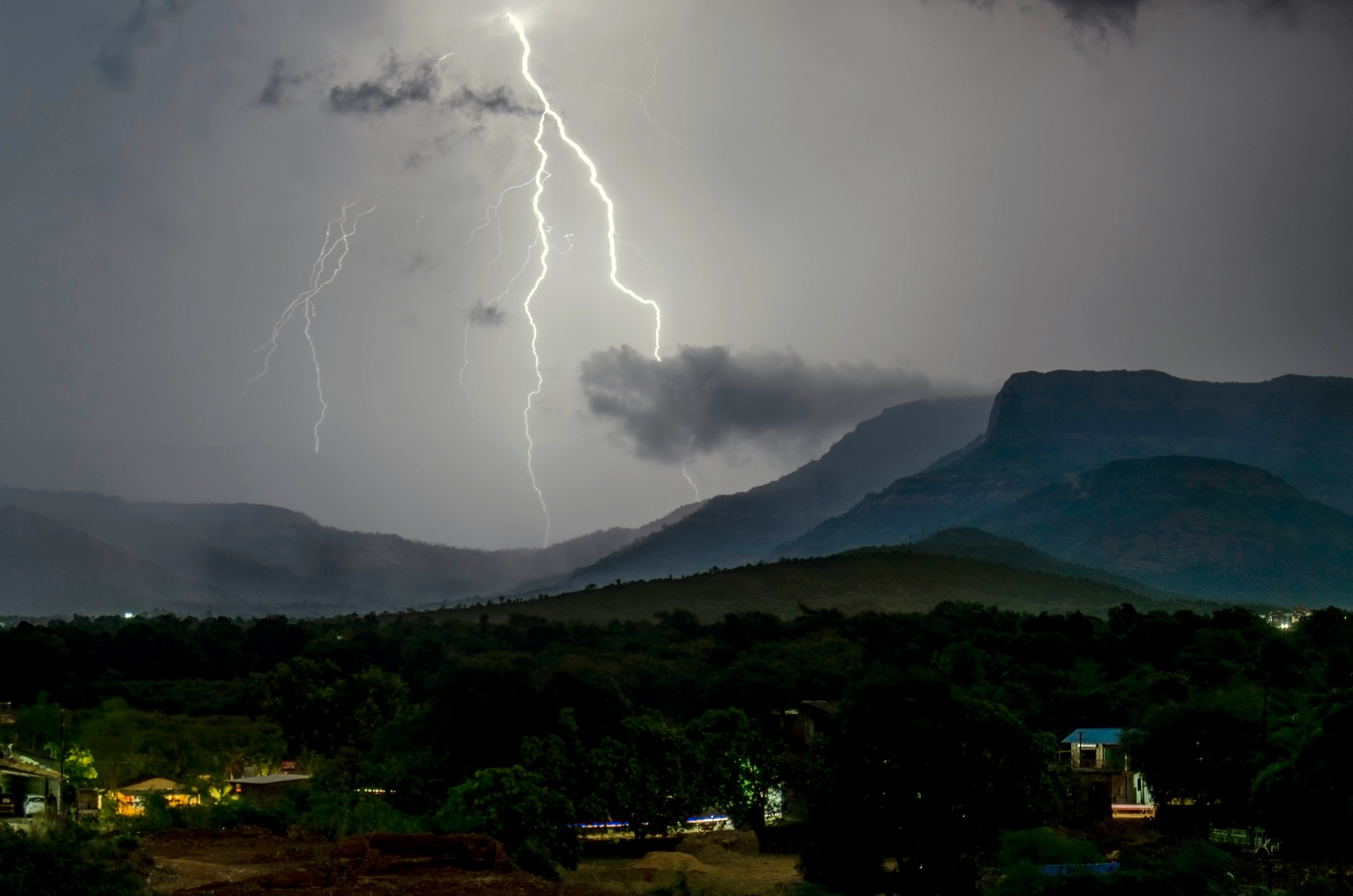Through local papers and word of mouth, volunteer Daya Shankar keeps track of a very specific cause of death. As soon as he receives news of someone being struck by lightning around his neighborhood in Jharkhand, East India, he picks up his motorcycle and heads to the destination. Sometimes he travels alone, other times with a team of five or six from the organization he volunteers for, the Lightning Resilient India Campaign. It’s a task he is undertaking increasingly often.
Last month, he rode to meet the Manjhi family, who lost an 8-year-old boy, Viresh, and his mother, Subodhra, after a tea stall they were sheltering under was struck during a storm. A lightning bolt can generate temperatures three times hotter than the surface of the sun, with a voltage millions of times higher than a household socket. If it connects with a human, it can stop the heart and respiratory system, damage the brain and nervous system, leave major burns, and cause blunt trauma if victims are flung by the force of being struck. On the day the Manjhis died, lightning also killed another person in the village and injured five others.
Each year, an estimated 24,000 people worldwide are killed by lightning. While a significant number, deaths per head of population have fallen sharply over the past two centuries, thanks largely due to urbanization, the protection of more substantial housing, and improved weather forecasting. But India’s large rural population remains badly affected. Between 2,000 and 3,000 Indians die annually by lightning, most of them working class people aged 10 to 50. Fatalities have risen by more than 50 percent since the turn of the century, outstripping population growth. Compare that to the US, where fatalities have been gradually falling and number around 20 a year. India can experience more than that number of deaths in a day.
Reported lightning strike fatalities in India. Data drawn from the Accidental Deaths and Suicides in India reports, 2000–2022, published by the National Crime Records Bureau.
For every person who is killed by lightning, roughly another nine are struck and survive, often with life-changing injuries. And with climate change making stormy weather and lightning more common, activists like Daya believe the Indian government is failing to protect its people. “A bare minimum would be to at least spread information about all things lightning at local government level,” says Daya.
India has systems in place to predict dangerous storms. These work by gathering a lot of precise data, says Sanjay Srivastava, chair of the Climate Resilient Observing-Systems Promotion Council (CROPC), an intergovernmental institute that works to develop resilience against climate change impacts. Srivastava is also the convener of the Lightning Resilient India Campaign.
“Detecting the precise location of a lightning cloud-to-ground strike is a calculation mechanism where a minimum of three devices are required,” says Srivastava. These are radio frequency detectors, to detect the radio waves produced by lightning; a doppler weather radar, to detect precipitation and wind patterns associated with storms that may produce lightning; and a lightning detector, a device specifically designed to detect the electromagnetic signals produced by lightning strikes.
As of April 2022, India’s National Remote Sensing Center had 46 lightning-detection sensors installed across the country. Another institute, Indian Institute of Tropical Meteorology, Pune, has 83 in place. These, along with other private and institutional data, monitor and guide India’s lightning strike warning system.
The data shows that Jharkhand and other neighboring regions in East and Central India are among the country’s hot spots, as they are where hot and dry air currents from the northwest meet moist easterly currents. When clouds encounter warmer air, moist air rises until it reaches the subzero temperatures of the upper atmosphere, where it can freeze into ice particles called graupel. As these then collide with other ice particles, they generate electrostatic charges, which can eventually lead to lightning. Rising global temperatures are increasing this phenomenon.
However, despite advancements in meteorology, the full mechanisms behind lightning’s formation and behavior remain partially shrouded in mystery. The precise triggers, the exact nature of how lightning propagates through the atmosphere, and the factors that determine the intensity of each strike are still not fully understood. The risk to human life can be predicted in only fairly broad terms.
And while these early warning systems exist, their information often does not reach people in time. This is why volunteers like Shankar work to inform people on how to stay safe and teach how to build easy-to-make lightning arrestors—devices that neutralize cloud-to-ground lightning.
The day Shankar visited the Manjhis’ house, it was drizzling. On the way he spotted farmers and locals sheltering under trees. He stopped to inform them that standing under a tree during rainfall increases the chances of getting hit by lightning. But they said there was no other place where they could take shelter.
Lightning strike casualties are more prevalent in rural areas where infrastructure is limited. Concrete houses, which can have protective Faraday cage effects, are less prominent there than in cities, while tall vegetation, which workers might shelter under, can attract strikes. Densely populated areas in stormy regions also see more casualties. “We can say there are two factors behind lightning casualties. There are lots of environmental factors, and then there are socioeconomic factors,” says Anand Shankar, who works at the India Meteorological Department at the Ministry of Earth Sciences in the state of Bihar (Anand and Daya are not related).
Increasingly, attention is focusing on air quality too. In recent research for Bihar, which neighbors Jharkhand and is one of the worst affected states in India, Anand found that particulate matter in the air increased lightning activity in the region. Aerosols such as pollution or dust particles can affect the friction between the particles that generate lightning and make it more common.
But to what extent growing casualties in Bihar can definitively be attributed to pollution or global warming isn’t yet clear, says Ashish Kumar, a colleague of Anand’s at the IMD. “We had no data before 2015–16, so we have not come to the conclusion whether this is happening recently due to climate change.” But Kumar doesn’t refrain from pointing out that a warming planet can lead to increased lightning activities. Research has projected that a 1 degree Celsius rise in temperature can lead to a 12 percent increase in lightning strikes.
When Daya reached the Manjhis’ house, the family told him that Viresh and Subodhra had taken shelter under a plastic-roofed tea stall because a storm had hit on their way back home from their farm. “People consider that saving themselves from the water is most important,” he says, but they fall prey to dangerous lightning strikes if they stand under something that can act as a conductor. “The best option for them would have been to find a concrete shelter.”
Spreading this sort of knowledge is why volunteers like Daya hunt for the places where recent lightning deaths have taken place. “We often arrange talk shows and plays and other things in the rural areas, but people are either too busy or not interested. But when such accidents take place, people get aware and are willing to listen,” he says.
Another way the Lightning Resilient India Campaign tries to reach the masses is through schoolchildren. “They are curious and spread the message in their families and communities,” Daya says. Warnings are also pushed through government hooters and through mobile applications like the Damini app, which triggers a warning notification before a lightning strike.
“It is not like a cyclone, where you have seven days and you are evacuating people,” says Srivastava. “It’s instant. So, those 30 minutes or three hours are the golden hours.” But often farmers who live far away from their houses do not bring mobile phones to their fields and leave very early for work, and might miss the warning alert.
Srivastava and Anand agree that the best solution would be to put up more lightning arrestors. But with limited funds and a lack of government support, campaign volunteers have to resort to promoting the use of DIY lightning arrestors in high-risk areas. These can be made by fixing the metal rim of a bicycle wheel high up on a bamboo stick and attaching the rim to the ground using copper wire. “They are not bad for a small area, but their efficiency is limited when compared with bigger lightning arrestors,” says Srivastava.
In the absence of adequate protections, 16 of the 36 states and union territories in India have started accepting lightning strikes as a state disaster, including Bihar and Jharkhand, and so pay out compensation money of 400,000 rupees ($4,766) to the family of a deceased person. This does something to help families handle the economic shock of losing someone, but still leaves thousands unsupported. “Only 10 percent of people die—90 percent are left with a social trauma,” says Srivastava. “We need to create a psychosocial relief and also proper medical treatment for those who survive,” he says.









